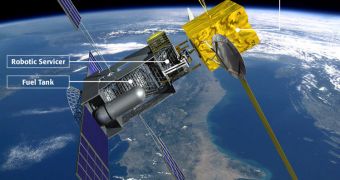A Canadian company announced plans to launch the first repair and refuel satellite in Earth's orbit by 2015. It has already signed a contract with a company operating such spacecraft, which thus became the first client to use such technologies.
The rationale behind having such a capability is rather simple – it costs less to constantly maintain and refuel satellites than to build new ones, and to have to pay for the delivery system as well.
For example, communications satellite company Intelsat agreed to pay MacDonald, Dettwiler and Associates Ltd. (MDA) more than $280 million over a few years for satellite servicing.
Building a just a single, new satellite would have cost Intelsat about the same amount, rocket included. As it stands, by using the MDA repair and refuel satellite, the company will pay the same amount, but have more of its satellites up and running way past their initial life span.
In most cases, spacecraft in orbit need to be retired when they consume all of their fuel, or suffer minor to moderate damage. The MDA orbital station will be able to address both these issues, providing fuel and minor technical repairs to other spacecraft in need.
At the same time, this type of intervention minimizes the risk of zombie satellites emerging in Earth's orbit. These are spacecraft that spend all their fuel, and then shut down before their managers get the chance to move them to a graveyard orbit, or burn them up upon atmospheric reentry.
If repair stations become available, then satellite companies will be able to exercise much tighter control over their assets, making the orbit a safer place for anyone, and contributing to stopping the rampant spread of space junk all around the planet.
MDA officials say that their innovative satellite design will allow their spacecraft to tow or refuel dead satellites in orbit, and then move on to assist other space assets. The design was dubbed the Space Infrastructure Servicing (SIS) vehicle.
“This is a first-time-ever, huge, huge, huge event. In the context of debris removal, this is the absolute best and absolute most fantastic new venture for the entire space community,” says Andrew Palowitch.
He holds an appointment as the director of the Space Protection Program. This is a joint venture of the United States Air Force (USAF) and the National Reconnaissance Office (NRO), the agency in charge of collecting space intelligence for the US.
In addition to carrying extra fuel for its targets, the SIS vehicle will also be outfitted with a robotic arm, which will enable operators to conduct basic repairs. No one is expecting it to fix heavily-damaged satellites, but the goal here is maintenance, not necessarily repair, Space reports.
“The way we look at it is, the best satellite you can have is the one that's already up there,” explains the MDA vice president for satellite missions, Steve Oldham.
“For the first time satellite operators and satellite users will have the choice of extending the lives of satellites. I think it can have a significant impact,” he adds.

 14 DAY TRIAL //
14 DAY TRIAL //